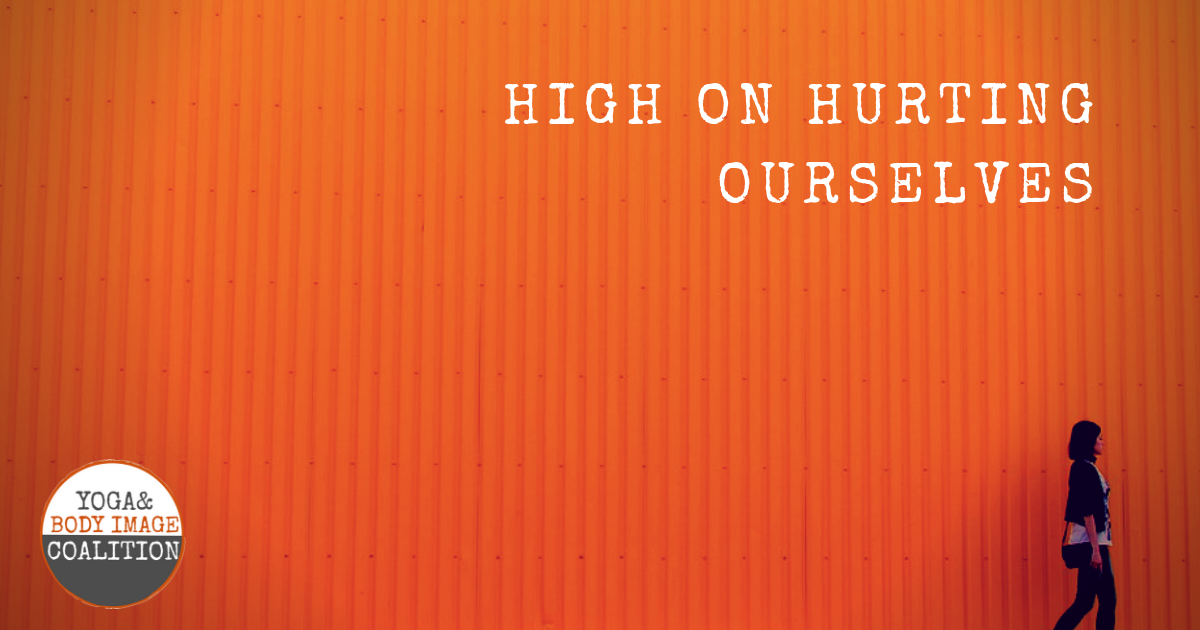High on Hurting Ourselves
September 10, 2019
The euphoric high of eating disorders
I spent most of my teens and twenties yoyo-ing between being under- and what I thought was overweight. I hated my body for regaining weight fast whenever I went into post-diet-compensation-mode. I remember my thighs in pink tights, mercilessly reflected in the floor-length mirror in ballett class, and my mothers X-ray eyes when she sized me up. I learned quickly that skinny was barely good enough and chubby was disgusting.
While reading the personal accounts in Yoga Rising I was immediately transported back to that time when certain foods were labeled as forbidden and self-hatred was on the daily menu.
Even though I came to yoga in my mid-twenties, it was only in my thirties that I found acceptance for my body. But the work never stops. My weight control issues are easily triggered by the old comparison game at the beach or pants feeling tighter than the week before.
I no longer give in, knowing well that the impulse to have control over my body is only a bandaid for some wound that’s more than skin-deep. But I remember the euphoric high from losing a significant amount of weight. The exaltation when pants and bras sat more loosely. And how I felt purified, untouchable and superior whenever I had shed a few kilos.
With a mother who ate only salad every night and who seemed to love me more when I was skinny, I had all the necessary components to develop a fully-fledged eating disorder. I have no idea why I never did. Somehow I must have loved myself enough.
Mortifying the flesh
I often hear people say that the media and fitness industry have promoted the skinny ideal over the last few decades. It’s true that we can’t escape the way we are constantly brainwashed. At the same time the shame, guilt, hatred and disgust connected to my body root deeper. They seem to be something generational that has been passed down for centuries.
I started thinking about the substratum of our culture, in my case, a largely Christian one. Not too long ago, monks and nuns spent a good portion of their lives whipping their own backs, wearing hairshirts or fasting for days on end. Even lay people went to confession and acknowledged that carnal desire and gluttony were sins and that the body was bad. It needed to be punished. The flesh had to be mortified.
This isn’t so different from the way we treat our bodies nowadays when we run for miles and avoid carbs like they’re the devil. We train hard and push our limits. We lift weights, run marathons and do yoga in heated spaces. We follow certain eating regimens and eat only raw food and drink our veggies. All the while trying to change something about our body, which is another way of saying: I’m not okay the way I am. And I will only love myself when I lose these extra kilos.
I guess my question is: Do we only do that because of the images we see everywhere? Or is the hatred and shame for our own body something that’s buried deep in our cellular memory? It seems to me that we’ve carried on the habit of self-chastizing from the past, getting a morbid sense of elation from it.
The pitfall of yoga
It’s true that yoga can be immensely healing for people with eating disorders or people who are completely disconnected from their physical sensations. However, as a yoga teacher and as someone who writes about yoga, I find that the pitfalls of the practice are not addressed enough.
Some of the more physically challenging or more traditional yoga styles, like Ahstanga, Bikram or Jivamukti, also Kundalini in its own way, can easily trigger the pattern of the perfectionist and the self-chastizing ascetic attitude. Even if the teacher means well, how is an A-type personality not going to be triggered when they hear they have to master the next pose in the Ashtanga sequence to move on in the series? And how is this person not going to grit their teeth and stick it out when they hear you’re not supposed to leave the room for the entire Bikram class?
We are okay with this self-inflicted pain because it gives us something. We become addicted to the pain because it gives us pleasure. The reason is the same now as it was a few centuries ago. It’s called the endorphin high.
High on natural painkillers
When we experience physical pain or emotional stress our brain releases endorphins (endogenous morphine, meaning morphine produced inside the body) to inhibit pain signals in the brain. Paradoxically, self-inflicted pain like vigorous exercise or making yourself throw-up can cause a sense of pleasure or euphoria. If we’re predisposed to torturing ourselves for the hit of endorphins, we’re likely to use yoga as a way of controlling our emotional state. If we enjoy the high after a strong workout, this is how we will go about our yoga practice.
I can’t say if we gain pleasure from pain because of our religious past or because of the neurochemical reaction in the body. Maybe there’s no one answer. What I do know is that we’re all too easily provoked into being unkind to our bodies and souls. Like I recently was this summer: After starting a new job and having more uncertainty in this area of my life, I started obsessing about my size again. Here, yoga can be the antidote. It can create space for us to observe how our mind works. And once we see how we hurt ourselves physically and emotionally, we may also start to explore the other, more loving options.

